lumber
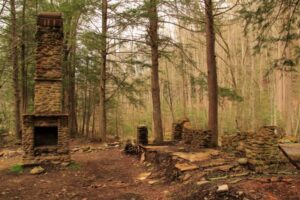 If you’ve ever been to the Smoky Mountains, then you know…you know just how beautiful they are. I’ve seen them, and they are beautiful. Nevertheless, there are things about the Smoky Mountains that I didn’t know. I love history and I love ghost towns, and now I find out that there is another one in the Smoky Mountains. It’s Daisy Town, Tennessee, and it has an interesting past. It was a century ago, when Daisy Town was thriving, that the Knoxville elites flocked to the Elkmont area. Sadly, today, the abandoned summer homes of Daisy Town make up a ghost town.
If you’ve ever been to the Smoky Mountains, then you know…you know just how beautiful they are. I’ve seen them, and they are beautiful. Nevertheless, there are things about the Smoky Mountains that I didn’t know. I love history and I love ghost towns, and now I find out that there is another one in the Smoky Mountains. It’s Daisy Town, Tennessee, and it has an interesting past. It was a century ago, when Daisy Town was thriving, that the Knoxville elites flocked to the Elkmont area. Sadly, today, the abandoned summer homes of Daisy Town make up a ghost town.
Elkmont started out in the 1830s, as a logging area, and so the moving into the area, and the area began to thrive. By the early 1900s, a lumber company built a railroad to transport the logs, and with that came people too, of course. When people saw that the area was going to make them rich, the affluent people who were living in Knoxville also began to visit the mountains finding them absolutely beautiful. They started building summer homes for themselves, and Daisy Town was born. By the 1920s, Elkmont was a summer playground for the city’s well-to-do population. Of course, if you wanted to spend your summers there, you would need money, so it was really an exclusive area.
The first thing built was the Appalachian Clubhouse, which was a social hub for the prominent members of 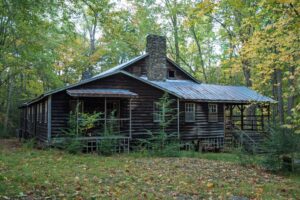 society, and with that and all the activities, came the cabins and cottages lining the one-lane road to the club. It was specifically this area that became known as Daisy Town. The club hosted dances, games, bingo, and horseshoes, through the 1920s and into the 1930s. Other areas, that had larger houses to draw the very wealthy, were nicknamed Millionaires Row and Society Hill. Nevertheless, time changes things, and even the fancy places like Daisy Town, Millionaires Row, and Society Hill have simply become the “Elkmont Ghost Town” and are nothing more than a tourist attraction for those of us who find ghost towns fascinating. It doesn’t detract from the beauty of the area, and for history buffs, like me, it probably adds to the attraction.
society, and with that and all the activities, came the cabins and cottages lining the one-lane road to the club. It was specifically this area that became known as Daisy Town. The club hosted dances, games, bingo, and horseshoes, through the 1920s and into the 1930s. Other areas, that had larger houses to draw the very wealthy, were nicknamed Millionaires Row and Society Hill. Nevertheless, time changes things, and even the fancy places like Daisy Town, Millionaires Row, and Society Hill have simply become the “Elkmont Ghost Town” and are nothing more than a tourist attraction for those of us who find ghost towns fascinating. It doesn’t detract from the beauty of the area, and for history buffs, like me, it probably adds to the attraction.
The whole decline of Daisy Town began in 1934, with the creation of the Great Smoky Mountains National Park. It didn’t happen overnight, of course, but the Elkmont area fell within the new park’s borders. The people who owned the homes weren’t forced out but were rather given a lifetime lease. Unfortunately for the families, the lease was not transferable, and as each owner died, the home was transferred to the park service. The slow end to Daisy Town and all the Elkmont vacation spots was complete by the early 1990s, leaving the park with 70 abandoned structures. Without proper care, the buildings began to decay, until all that was left was the eerie reminders of their heyday, such as is common to ghost towns.

All is not lost for Daisy Town, however. While the cabins and cottages are closed to the public, you can look inside and picture happier times. The Appalachian Clubhouse was given a different fate. The park service decided to restore it so that it could be used for events. Not only that, but nineteen other structures around Elkmont are slated for renovation by 2025, something I think is very cool. It’s sad to see these parts of our history being allowed to fall apart and disappear. For now, the walk along Jakes Creek Trail will provide view of this historic little area where you can still see chimneys, walls, and other remains of 1920s cabins. It’s an area I hope to visit one day.

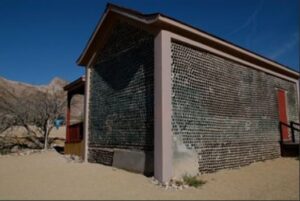 When we think of structures that have stood the test of time, we think of stone structures or structures made out of hard woods that are able to weather the elements, but sometimes a structure defies the normal expectations, as stands the test of time against all odds. There is a house in the ghost town of Rhyolite, Nevada that is the perfect example of that kind of structure.
When we think of structures that have stood the test of time, we think of stone structures or structures made out of hard woods that are able to weather the elements, but sometimes a structure defies the normal expectations, as stands the test of time against all odds. There is a house in the ghost town of Rhyolite, Nevada that is the perfect example of that kind of structure.
A local saloon owner named Tom Kelly decided to build a house in 1906. Unfortunately, lumber was scarce in the area at the time, so the innovative 76-year-old saloon owner decided to use the materials at hand to build his house…bottles. Not many people would have come up with such an idea, much less have the ability to carry out the strange design and actually make it a house. An estimated 50,000 beer, whiskey, soda, and medicine bottles were used to build the structure, and amazingly, it is still standing today. Tom Kelley was 76 years old when he built the house that took him almost six months to complete. Thankfully he didn’t have to drink all the alcohol in those 50,000 bottles. The bottle house also sports a “garden” of sculptures made of broken glass 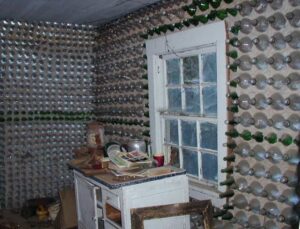 including miniature houses, bottle ropes, and a host of other “glass treasures” that would probably qualify as junk to most of us, but they seem to fit the bottle house perfectly.
including miniature houses, bottle ropes, and a host of other “glass treasures” that would probably qualify as junk to most of us, but they seem to fit the bottle house perfectly.
There was a period of time when the house was in some disrepair, but amazingly it was things like needing a new roof that caused the disrepair, not broken bottles in the structure. In 1925, Paramount Pictures wanted to use the house in a movie, so as part of the deal, they restored and re-roofed the house. The house, which really is pretty cute, was given to the Beatty Improvement Association for maintenance as a historical site. That might be part of why it still stands today, but the work that went into it originally was a big part of the house’s ability to stand the test of time.
Louis J Murphy leased and maintained the house as a museum that he ran with a woman named Bessie Stratton Moffat until he died in 1956. Later, a man named Tommy Thompson and his wife lived in the house, while maintaining a museum and a relic shop. How unique it must have been to live in such a house. No, it’s not a big house, and probably doesn’t have a monetary value that would rival today’s market, but its value really lies in a different area. The house fit the Thompsons, however. Tommy was a musician, who worked 
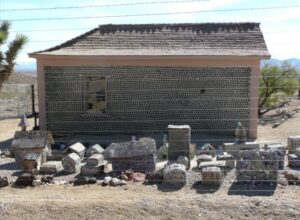 playing the accordion in the saloons in Rhyolite back when it was a boomtown. Evan Thompson maintained the house for a while after his parents died. He is the last person to actually live in the house, but he finally moved on, living in Pioneer, Nevada now. Once again, the bottle house stands empty, no longer in use, but still as resilient as ever.
playing the accordion in the saloons in Rhyolite back when it was a boomtown. Evan Thompson maintained the house for a while after his parents died. He is the last person to actually live in the house, but he finally moved on, living in Pioneer, Nevada now. Once again, the bottle house stands empty, no longer in use, but still as resilient as ever.
 The lumber industry is a well known part of Grays Harbor County, Washington. Cities like Aberdeen and Hoquiam owe their existence to the lumber industry. During the first quarter of the 20th century, Grays Harbor was considered as the biggest lumber-producing and lumber-shipping region in the world. It would be great if timber came in perfect sizes and shapes, but it doesn’t. It comes in forms from huge logs to tiny planks, from thick wooden beams to thin spruce veneer. When it comes to the construction industry, bits and pieces are worthless. They want specific sizes and shapes, and in order to get those perfect pieces of lumber for the construction industry, there is always waste. It might come in the form of small blocks to super thin veneer pieces.
The lumber industry is a well known part of Grays Harbor County, Washington. Cities like Aberdeen and Hoquiam owe their existence to the lumber industry. During the first quarter of the 20th century, Grays Harbor was considered as the biggest lumber-producing and lumber-shipping region in the world. It would be great if timber came in perfect sizes and shapes, but it doesn’t. It comes in forms from huge logs to tiny planks, from thick wooden beams to thin spruce veneer. When it comes to the construction industry, bits and pieces are worthless. They want specific sizes and shapes, and in order to get those perfect pieces of lumber for the construction industry, there is always waste. It might come in the form of small blocks to super thin veneer pieces.
Wood has long been used in the fashion industry too. Everything from shoes, to decorations on purses, belts, hats and more, but that was about the extent of it, or so you might think. Apparently, somebody back in 1929 thought that wood veneer sheets could be used as a bathing suit material!! What!! That makes no sense at all. It was totally impractical, but that didn’t stop people from the Gray Harbor Lumber industry from starting an advertising campaign featuring the “Spruce Girls.” The main goal of the campaign was to promote the various products of the wood industry and to make the whole region more popular to visitors.

Spruce veneer bathing suits were described as simple, cheap, and easy to make, yet fashionable and modern. Supposedly they were promoting them as a do it yourself bathing suit. All you needed was a pattern and the leftover thing strips of wood from that construction project. Of course, it was an advertising gimmick, but they did actually made four suits, held a photo session, and ran an advertising campaign to promote wood products.
According to one Popular Science magazine article, the suits were quite trendy and durable: “[Wooden bathing suits] are the latest novelty for use on the bathing beaches. Fashioned of thin spruce, they are said to be practical as costumes and also are sufficiently buoyant to encourage a timid swimmer to take a plunge. So far, none of them has warped or cracked.” The girls in the pictures look happy with their flimsy wooden suits, but only they know if they were really comfortable. My guess is don’t bend at the waist, and watch out for splinters.
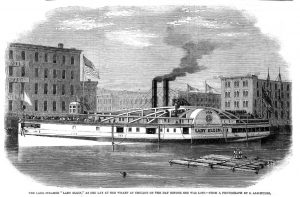 Just before midnight on September 7, 1860, a palatial sidewheel steamboat named the Lady Elgin left Chicago bound for Milwaukee. She was carrying about 400 passengers. She was returning to Milwaukee from a day-long outing to Chicago. Also on the water that night was the Augusta, a schooner filled with lumber. The captain of the Lady Elgin took notice of the Augusta around 2:30am. The night was stormy, and visibility was poor. Storm clouds raged and the waves were intense.
Just before midnight on September 7, 1860, a palatial sidewheel steamboat named the Lady Elgin left Chicago bound for Milwaukee. She was carrying about 400 passengers. She was returning to Milwaukee from a day-long outing to Chicago. Also on the water that night was the Augusta, a schooner filled with lumber. The captain of the Lady Elgin took notice of the Augusta around 2:30am. The night was stormy, and visibility was poor. Storm clouds raged and the waves were intense.
Suddenly, the lumber on the Augusta shifted, causing the two ships to collide. Instantly, the party atmosphere that had been on the Lady Elgin, turned to chaos and confusion. The Augusta received only minor damage in the collision, and kept right on sailing to Chicago. It wasn’t an unusual occurrence in those days. It’s possible that the Augusta assumed that if it wasn’t badly hurt, that larger ship probably wasn’t either. I can’t say for sure, but I know that this collision, in which the Augusta did not stop is not the first I have heard of such an incident in Maritime history. A large hole in the side of the Lady Elgin doomed the ship, which sank within thirty minutes. Only three lifeboats were able to be loaded and set into the water. The ships large upper hurricane deck fell straight into the water and served as a raft for some forty people.
The ship had crashed two to three miles off the shore of Highland Park, but the waves were so strong that survivors, bodies, and debris were all swept down to the northern shore of Winnetka. In those days, the lakeshore in this area consisted of a narrow strip of beach rising up to clay cliffs almost 50 feet high. An angry line of breakers churned up from the storm were crashing ashore. Around 6:30am the first of the three lifeboats made it to shore in the vicinity of the Jared Gage house…which still stands at 1175 Whitebridge Hill Road. A desperate call for assistance went out to the town from the Gage house. The people of Winnetka rode 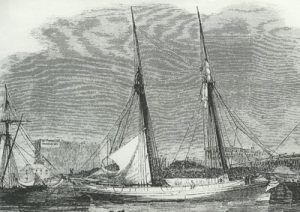 horses down to Northwestern University and the Garrett Biblical Institute to find any young men to help pull out survivors. The regional newspapers were quickly informed by telegraph. The newly completed Chicago and Milwaukee train line brought people to Winnetka to help as word of the accident spread. The effort to save the people on the Lady Elgin would have been a phenomenal feat today, but it was carried out in 1860, making it even more amazing.
horses down to Northwestern University and the Garrett Biblical Institute to find any young men to help pull out survivors. The regional newspapers were quickly informed by telegraph. The newly completed Chicago and Milwaukee train line brought people to Winnetka to help as word of the accident spread. The effort to save the people on the Lady Elgin would have been a phenomenal feat today, but it was carried out in 1860, making it even more amazing.
The crowds on the bluffs and beaches watched as pieces of wreckage washed up near the site of the present Winnetka water tower. By 10:00am, the bluffs were littered with people who had been strong enough to withstand the fierce storm of the previous night. Lastly came the hurricane deck with Captain Wilson and eight survivors whom the storm had thus far spared. Then, before their eyes, this storm-battered deck was dashed to pieces on an offshore sandbar and all on board were lost.
The storm left a tremendous undertow, creating the tragic situation…the exhausted victims had drifted close enough to the Winnetka shore to see it, only to be held back by the breakers. As the horrified onlookers watch, they died in full view of the people on shore, who could do nothing but watch. Men were lowered from the bluff with rope tied around their waists in attempts to pull people in to safety. One Evanston seminary student, Edward Spencer, is credited with saving 18 lives. Spencer is said to have repeatedly rushed into the sea, being battered by debris in order to save more people. I do not know, but I suspect that he is some relation to me on my Spencer side, and I feel honored that he was such a heroic figure. Spencer is said to have wondered many times in the aftermath, “Did I do my best?” It is the mark of a hero, never to feel like they did enough. Another man, Joseph Conrad, was said to have pulled 28 to safety. Other unknown rescuers pulled in survivors up and 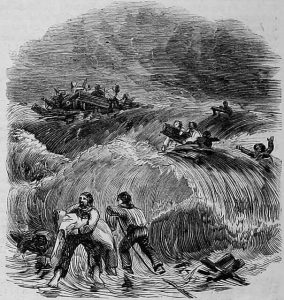 down the Winnetka and North Shore coastline.
down the Winnetka and North Shore coastline.
The Gage house, the Artemas Carter house at 515 Sheridan Road, and other Winnetka residences served as temporary hospitals. The newly-built Winnetka train depot served as a morgue. Winnetka residents brought food and clothing for the survivors. It is estimated that 302 people lost their lives that day, the exact number is unknown, as the ships manifest went down with the ship. The 1860 census shows only 130 residents in the town of Winnetka. The tragedy captured the nation’s attention, but was quickly overshadowed by the 1860 elections and the Civil War. Such is the way of things. An tragic event is only well remembered, until another comes to take its place.
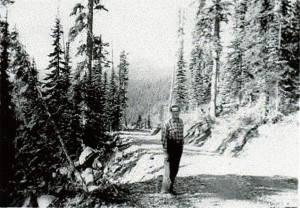 During the Depression years, many people were looking for work…any kind of work, because jobs were scarce, and money even more so. Many men were forced to leave their wives and young children to run the farms, so they could go out, sometimes several states away to look for work. It wasn’t just the husbands either. Many times, as in the case of my dad and my Uncle Bill, it was the sons who had to go find jobs too, because the family was simply not going to make ends meet if they didn’t. So it was that Dad and Uncle Bill set out for the Whitefish, Montana area to look for work. This trip would be quite an experience for the two brothers, who were in their teens at the time. It is my guess that my dad would have been around 15 years and Uncle Bill 17 years old at this time, but I could be off by a year or two. It doesn’t matter, because they were, nevertheless young.
During the Depression years, many people were looking for work…any kind of work, because jobs were scarce, and money even more so. Many men were forced to leave their wives and young children to run the farms, so they could go out, sometimes several states away to look for work. It wasn’t just the husbands either. Many times, as in the case of my dad and my Uncle Bill, it was the sons who had to go find jobs too, because the family was simply not going to make ends meet if they didn’t. So it was that Dad and Uncle Bill set out for the Whitefish, Montana area to look for work. This trip would be quite an experience for the two brothers, who were in their teens at the time. It is my guess that my dad would have been around 15 years and Uncle Bill 17 years old at this time, but I could be off by a year or two. It doesn’t matter, because they were, nevertheless young.
They got to Fosston, Minnesota that first night…taking it easy on Uncle Bill’s old Plymouth, and arriving about 8:30pm. They tried to find a room to rent for the night, but there were  none, and then someone said they could sleep at the jail, so they went to check it out. They were allowed to spend the night there, after showing identification, being searched, and leaving all their belongings except their clothes in the office. I’m sure they were really wondering if they would turn them loose the next morning, after such an ordeal, but while the beds were not the most comfortable, they had a place to sleep. Needless to say, they left Fosston the next morning, and headed to Osnabruck, North Dakota the next day, where they found work unloading bags of cement from a rail road box car. By the end of the day, they were exhausted and pretty certain that they couldn’t have lifted one more bag…no matter how much money was offered. They found a man and his son who had a threshing machine and several farms lined out to do threshing for, but not enough help, so they worked for him until continued rain ended the threshing for the year.
none, and then someone said they could sleep at the jail, so they went to check it out. They were allowed to spend the night there, after showing identification, being searched, and leaving all their belongings except their clothes in the office. I’m sure they were really wondering if they would turn them loose the next morning, after such an ordeal, but while the beds were not the most comfortable, they had a place to sleep. Needless to say, they left Fosston the next morning, and headed to Osnabruck, North Dakota the next day, where they found work unloading bags of cement from a rail road box car. By the end of the day, they were exhausted and pretty certain that they couldn’t have lifted one more bag…no matter how much money was offered. They found a man and his son who had a threshing machine and several farms lined out to do threshing for, but not enough help, so they worked for him until continued rain ended the threshing for the year.
Then, they decided to get out of North Dakota, and headed for Whitefish, Montana where they worked in the lumber business for a company called Kinshella Lumber, in the 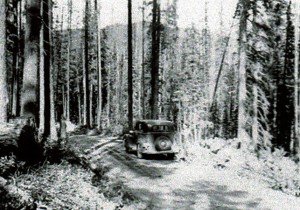 beautiful mountains outside Whitefish. That area was one that they found to be a great place for adventure, and they spent a lot of time driving in the mountains when they were working. It was a time they would remember fondly, until October arrived, bringing with it some very cold weather. By this time, both boys were pretty much done with this trip, so they set out for home, with enough money to make another payment on the farm. They had an interesting adventure, to say the least, but I’m sure that grandma’s good cooking and their own beds were calling their names, and as Uncle Bill said, there was wood to be cut up for the stove.
beautiful mountains outside Whitefish. That area was one that they found to be a great place for adventure, and they spent a lot of time driving in the mountains when they were working. It was a time they would remember fondly, until October arrived, bringing with it some very cold weather. By this time, both boys were pretty much done with this trip, so they set out for home, with enough money to make another payment on the farm. They had an interesting adventure, to say the least, but I’m sure that grandma’s good cooking and their own beds were calling their names, and as Uncle Bill said, there was wood to be cut up for the stove.
 My Grandma Spencer’s photo album contains a number of pictures from the days when the family lived in International Falls, Minnesota, and worked in the lumber business, and I assume, the paper mill there in town. If the family didn’t work there, then I would assume that she was simply interested in all the changes that were taking place in the area. At that time, the big man around town was a man named Edward Backus, who owned a vast empire of lumber and paper mills. Oddly, he originally got into that business as a young college student in need of money to finish his university program. He took time off from college to earn that money, took a job in the lumber business, and bought into the business, before finally buying out his partners to become the sole owner. He later brought in a partner, William Brooks, and together they incorporated, and their company Backus-Brooks Co. bacame the parent company for for numerous subsidiaries that came into being with developments at International Falls, Fort Frances, Kenora and elsewhere. The little sawmill in Minneapolis that started it all, was
My Grandma Spencer’s photo album contains a number of pictures from the days when the family lived in International Falls, Minnesota, and worked in the lumber business, and I assume, the paper mill there in town. If the family didn’t work there, then I would assume that she was simply interested in all the changes that were taking place in the area. At that time, the big man around town was a man named Edward Backus, who owned a vast empire of lumber and paper mills. Oddly, he originally got into that business as a young college student in need of money to finish his university program. He took time off from college to earn that money, took a job in the lumber business, and bought into the business, before finally buying out his partners to become the sole owner. He later brought in a partner, William Brooks, and together they incorporated, and their company Backus-Brooks Co. bacame the parent company for for numerous subsidiaries that came into being with developments at International Falls, Fort Frances, Kenora and elsewhere. The little sawmill in Minneapolis that started it all, was 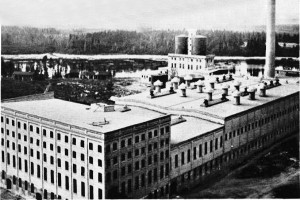 sold in 1906 because by then, the owners were devoting much of their efforts into the developing industry in the north, which is where my grandparents’ families came into the picture, and my interest was founded. As a side note, as far as I can tell, Mr Backus never went back to finish his university program, but then I suppose there wasn’t time for that with everything else that was going on in his life.
sold in 1906 because by then, the owners were devoting much of their efforts into the developing industry in the north, which is where my grandparents’ families came into the picture, and my interest was founded. As a side note, as far as I can tell, Mr Backus never went back to finish his university program, but then I suppose there wasn’t time for that with everything else that was going on in his life.
As I said, my grandmother had numerous pictures of a paper mill, in several stages of its construction. This got me started wondering if that paper mill still existed. I began my search looking for paper mills in International Falls, and came up with a current paper mill owned by Boise Cascade…a name most of us know quite well, which came back into the news just recently when they announced the layoff of 265 workers on May 2, 2013. They plan to stay open, but will focus on the successful lines of their production, and close out two unsuccessful lines. I wondered if this paper mill could have started with the one my grandmother’s pictures to me so much about.

In my research, I found not only the information on Mr Backus, but a picture of his paper mill…Falls Paper Mill…and it was indeed the one in my grandmother’s album. So, not only does the paper mill still exist, it is still in use today. So many buildings that were built in the early 1900’s are crumbling or have been demolished, but this building is still there, still standing, and still useful, although it appears that there have been some improvements and buildings added to it and around it. I guess that goes to show that good workmanship will stand the test of time.
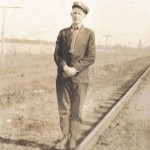 With the advent of the railroad in America back in the early 1820’s, came the fascination with trains and the railroad in general. It is a fascination that has never really ended. Even though some of our railroad tracks are now being dismantled, I don’t believe that the railroad will ever really go away. So many things are transported by rail, many of which could not feasibly be transported any other way…coal being one of the biggest industries to which the railroad is vital. My family worked in the lumber industry back in the early 1900’s, and at that time lumber and lumber products were transported by rail. There were no semi-trucks to transport things, so most things were transported to other areas of the country by rail.
With the advent of the railroad in America back in the early 1820’s, came the fascination with trains and the railroad in general. It is a fascination that has never really ended. Even though some of our railroad tracks are now being dismantled, I don’t believe that the railroad will ever really go away. So many things are transported by rail, many of which could not feasibly be transported any other way…coal being one of the biggest industries to which the railroad is vital. My family worked in the lumber industry back in the early 1900’s, and at that time lumber and lumber products were transported by rail. There were no semi-trucks to transport things, so most things were transported to other areas of the country by rail.
Early on there were huge ceremonies to celebrate the railroads entrance into a new town. 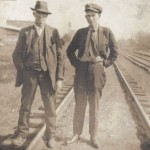 People just understood how important the railroad was to their way of life. Travel became easier, supplies and mail reached people faster, and the standard of living in the West vastly improved. It was a win win situation for everyone concerned
People just understood how important the railroad was to their way of life. Travel became easier, supplies and mail reached people faster, and the standard of living in the West vastly improved. It was a win win situation for everyone concerned
With all those changes, also came the advent of the railroad photo op. Everyone wanted their picture taken by the tracks, it seems. I have come across several pictures where the railroad tracks are the main focus of the shot. I can understand the fascination, but I was surprised by the number of people who felt the same way I did about them. Pictures weren’t as common back in the early 1900’s, although they were apparently more common than I would have thought. Still, no matter the cost, no matter how frivolous, people wanted pictures with the railroad in them. It was such a novelty, and it was a piece of history. It was their chance to prove that they were there.

Apparently, not much has changed over the decades or even the last century, because it seems to be the latest thing again, to have your picture taken on or beside the railroad tracks. Senior pictures and even family pictures are being taken there by lots of photographers, like my friend, Tammie Williamson of Williamson Creations Photography. Tammie displays railroad photographs on her photography site quite a bit. Like so many other people throughout history, she and many other people today still like the tracks for photographs. It’s just part of our fascination with the railroad, the trains, and the tracks that move them along.
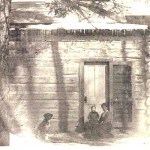 In years gone by, when it wasn’t as easy to get to your job site as it is today, many people lived as near their work as possible, especially when their work was out in the woods. Jobs in the cities and towns don’t require long drives, but when you travel on a horse, and work from sunrise to sunset; it’s nice to be close to home. Working in the logging industry, like my grandparents did, living in the woods was just part of the job.
In years gone by, when it wasn’t as easy to get to your job site as it is today, many people lived as near their work as possible, especially when their work was out in the woods. Jobs in the cities and towns don’t require long drives, but when you travel on a horse, and work from sunrise to sunset; it’s nice to be close to home. Working in the logging industry, like my grandparents did, living in the woods was just part of the job.
I’m told that their little cabin in the woods was near International Falls, Minnesota, where their daughter, my Aunt Laura was born. I would imagine that the winters were very cold there, and the best thing for anyone who could was to stay indoors, but them I seriously doubt that my grandmother was a woman who was afraid of a little but of cold and snow. Still, the cold and snow would really make it hard to work out in the woods…nevertheless, that was the job that had to be done. Maybe that was another good reason to live near your work. You could get home to the nice warm house sooner, and maybe 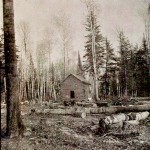 even be able to go home for lunch.
even be able to go home for lunch.
When I look at these pictures, it reminds me of the “Little House on the Prairie” books. Everywhere you look seems to be a new adventure. I can imagine how the Ingalls girls felt living there…the adventures they must have had…the adventures my Aunt Laura must have had there, playing with the children of the other logging families that lived in the woods too. I’m sure there was an abundance of forest animals to see and be in awe of. I love photographing the animals…when I happen to be in the right place at the right time. The pictures can be amazing. I can imagine all the beauty all around the little cabin in the woods.
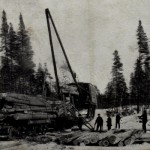 For a number of years some of my dad’s family worked in the lumber business like so many other people from the area near International Falls, Minnesota and northern Minnesota, North Dakota, and Wisconsin. Much of the lumber was then sent to the Sawmill and Paper mill in International Falls. The year was somewhere around 1912, and the equipment used was not like what is used in the lumber business of today. After the logs were dragged or “skidded” to the railroad, they were loaded on to the rail cars by a Yarder. A Yarder was a machine that traveled on railroads knows as “dummy lines” to the site where the logs were to be loaded. These machines appeared to be large and cumbersome, they were in reality, workhorses that could handle big jobs. Once the logs were hooked to the cables, the log could be skidded at a rate of 1000 feet per minute…making work around the machines, rather dangerous. Once the log was near the rail car, men and machines had to work together using cables and poles to load the logs onto the railroad car. Once again, this put the men in harm’s way. If a log slipped, it was very likely that it was going to hit someone, resulting in death or at the very least, serious injury.
For a number of years some of my dad’s family worked in the lumber business like so many other people from the area near International Falls, Minnesota and northern Minnesota, North Dakota, and Wisconsin. Much of the lumber was then sent to the Sawmill and Paper mill in International Falls. The year was somewhere around 1912, and the equipment used was not like what is used in the lumber business of today. After the logs were dragged or “skidded” to the railroad, they were loaded on to the rail cars by a Yarder. A Yarder was a machine that traveled on railroads knows as “dummy lines” to the site where the logs were to be loaded. These machines appeared to be large and cumbersome, they were in reality, workhorses that could handle big jobs. Once the logs were hooked to the cables, the log could be skidded at a rate of 1000 feet per minute…making work around the machines, rather dangerous. Once the log was near the rail car, men and machines had to work together using cables and poles to load the logs onto the railroad car. Once again, this put the men in harm’s way. If a log slipped, it was very likely that it was going to hit someone, resulting in death or at the very least, serious injury.
I’m not sure what my dad’s family member’s jobs were in that industry, but that would have been around the time they were working in that industry. Logging has always been a dangerous industry to be in anyway, due to the large trees falling. You can’t always predict exactly where they are going to fall, although they know more about that these days than they used to. Still, the thought of a log being pulled from one point to another at the rate of 1,000 feet a minute and having someone in the way of that…makes me cringe!!
When I was watching some of the old home movies from Bob’s family, I saw that some of them were in that same industry for a time. There was a stark difference in the way trees  were moved from place to place. The Harvester was able to go up into the area where the trees were being cut, and bring them down to the loader. The loader being on wheels, with a Diesel engine, was them able to lift the logs onto the trucks, without the need to “skid” them closer. No one needed to be around to work cables or anything else to get the logs on the truck. It made for a much safer situation for everyone concerned. Of course, every invention that we now had, came from a need seen by someone in the past, so I guess we have those loggers in the old days to thank for the safer conditions we now have. I’m just thankful that my ancestors lived through the time they spent in that industry.
were moved from place to place. The Harvester was able to go up into the area where the trees were being cut, and bring them down to the loader. The loader being on wheels, with a Diesel engine, was them able to lift the logs onto the trucks, without the need to “skid” them closer. No one needed to be around to work cables or anything else to get the logs on the truck. It made for a much safer situation for everyone concerned. Of course, every invention that we now had, came from a need seen by someone in the past, so I guess we have those loggers in the old days to thank for the safer conditions we now have. I’m just thankful that my ancestors lived through the time they spent in that industry.

